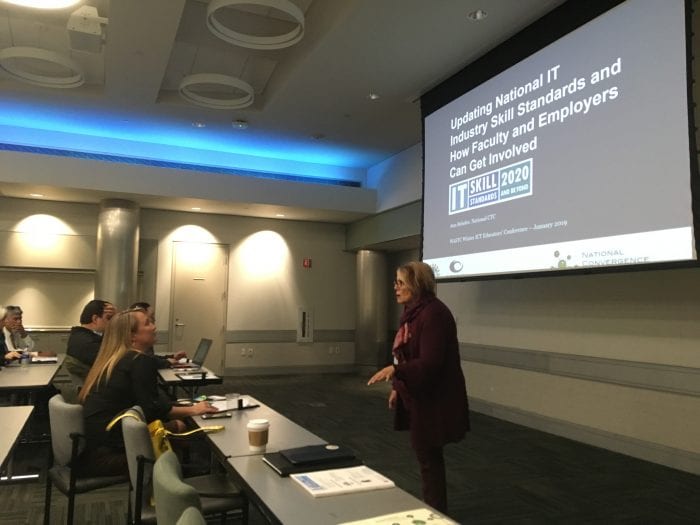Four Things We Heard at WASTC
The National Convergence Technology Center (CTC) is a proud co-producer of the WASTC Winter ICT Educators conference in San Jose, California. CTC staff recently attended this conference and participated in three breakout presentations covering:
- key strategies of its Business and Industry Leadership Team (BILT) model(link to the BILT brochure?)that helps align curriculum to workforce needs (a big thank you to NetApp’s Mercedes Adams for sharing her perspectives!)
- an ambitious new initiative to update IT skill standards nationwide by convening a wide network of IT thought leaders and employers
- a look at different programs that offer students with AAS degrees a pathway to Bachelor’s degrees.

Dr. Ann Beheler discusses updating National IT Industry Skill Standards during the WASTC conference.
Aside from those presentations, the CTC attended a number of other breakout sessions and keynote addresses. This conference always offers a “big picture” look at the trends and practices in the education and industry landscape, particularly from the point of view of educators and employers on the West Coast.
Here’s a sample of some of the more notable things we heard…
- The looming shortfall of IT workers continues to loom.Two morning keynotes featured a litany of shocking statistics. By 2021, 3.5 million cybersecurity jobs will be unfilled. By 2027, there will be a 59% shortfall in workers with needed programming skills. As a corollary to that, the IT world will not only demand more and more workers, but will be undergoing huge changes. Salesforce.com reports that in many industries, the next three years will see more change than the previous 30 years. Any way you slice it, the demand for IT technicians is increasing and education will have to do more to keep up.
- Interpersonal soft skills are often more important than hard technical skills. Josh Davies from the Center for Work Ethic always gives an entertaining, dynamic performance about the lack of soft skills in students and new hires (you can see his enter slide deck here.) For four years in a row, an employer survey ranked work ethic as the most important trait of a worker and education as the least important, vividly illustrating a disconnect between what employers need and what educators teach. Another survey reports that 77% of manager consider soft skills as important as technical skills with another 16% calling soft skills more important than technical skills. A Forbes study noted that 46% of workers are fired after 18 months; of those, 89% were let go because of poor attitude, not because of any problem with technical know-how. Another keynote speaker from Cisco listed a number of highly technical skills IT workers need to know in today’s workforce that included things like virtual topology systems. His list also included something more simple: presentation skills. He urged students to record themselves giving a presentation so they can see what the audience sees. If you’re not emphasizing and practicing soft skills in every class in your program, you should be.
- An on-campus, student-run PC repair clinic is one way to teach soft skills. Cleveland Community College in North Carolina uses a PC repair clinic to teach students customer service skills. Second-year students have the chance to pursue their required service/volunteer hours by working in the clinic. The work gives students practical experience working with customers of all ages from intake of the broken device all the way through delivery of the repaired device. Beyond this, Cleveland Community College has embedded employability skills in all of its IT classes, whether its mandatory discussion board use or a zero-tolerance policy of missing deadlines or a requirement to dress professionally as if the classroom was a job. Some attending this session asked about the need to get approval for curriculum changes, but because Cleveland Community College adjusted the approved curriculum and made changes of no more than 20%, additional approvals weren’t needed.
- There’s an internet in space. Technology guru Laura Chappell showcased NASA’s plan to create an “IPN” (interplanetary network) based on Vint Cerf’s “delay tolerant network” model. A DTN system is already used for delivering data and images to NASA from probes, satellites, and landers outside Earth’s orbit, like Mars or the distant Voyager explorers. DTN relays information in a way that overcomes outer space transmission problems, whether it’s the vast distances or the physical obstacles created by orbiting planets and moons. Learn more here and here.
